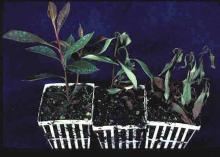Cause Cylindrocladium scoparium, (sexual Calonectria morganii), a fungus but other species can be involved. The disease has been a problem only in greenhouses. Microsclerotia that form in plant tissues can survive many years in soil or media. New infected cuttings from other facilities can also bring in inoculum. Cuttings may have small inconspicuous leaf spots. High humidity and high temperatures (85°F) favor fungus growth. Spores may be carried in soil, water, by the wind, or on hands. Conidia that land on leaves or flowers germinate and penetrate through stomata or directly through the epidermis. Sporulation will not occur in leaf or flower spots while still attached to the plant. Once these tissues fall from the plant the fungus colonizes and forms microsclerotia. Microsclerotia can now produce conidia that keep the cycle going.
Conidia can also be washed into soil or media. The fungus may invade roots' vascular tissues. Vascular browning may occur up the stem, but the fungus does not progress more than an inch or so above the soil line. Even though the fungus often appears to have invaded at or near the soil line (possibly through wounds), it will invade roots. The fungus has been recovered from as deep as 12 inches in soil. Latent root infections where the fungus progresses slowly may account for many of the sudden wilts in plants that are several years old. Stress from shipping, repotting, extra watering, and fertilizing can trigger collapse symptoms.
Symptoms Cylindrocladium may cause a leaf spot, stem canker, flower spot, root rot, or quick wilt.
Leaf spots are discrete with necrotic centers. Spots are surrounded by a chlorotic halo on white cultivars and a light brown to pinkish zone on pink or red cultivars. Veins on the bottom of leaves may radiate pinkish red from spots on pink or red cultivars. Necrotic flecks may be seen on flowers before they collapse.
Above ground symptoms of root rot include stunting, foliage discoloration, and wilting. These symptoms may not occur until roots have been rotted for some time. Roots decay with a cortical rot. Vascular discoloration may extend beyond root lesions. Woody stems may also have an internal distinct brown discoloration.
Cultural control
- Keep humidity as low as practical.
- Use only disease-free cuttings in disease-free soil or soilless potting media. Tissue-culture source plants are another good way to break the cycle.
- Remove and destroy infected plants and fallen leaves. In addition, cull healthy appearing plants around the known infected plants as they too may be infected. Be careful not to contaminate surrounding plants with contaminated soil or plant debris. Place diseased plants in a closed container if not immediately removed from the house.
- Avoid reusing pots from a previous crop for propagation. If pots must be reused then wash off all debris then soak in a sanitizing solution or treat with aerated steam for 30 min.
Chemical control Do not use on infected plants as chemicals are for protection only and will not cure plants. Successful only if combined with good sanitation and other cultural controls. Spray stock plants prior to cutting selection. After cuttings are stuck, follow up with drenches.
Immersing cuttings in a fungicide or disinfectant solution for several minutes can be an effective control tactic but is not generally recommended. A few infected cuttings can contaminate the entire batch with disastrous results. It is better to use products before cuttings are taken and/or after sticking.
- Drench:
- Avelyo at 2 to 3 fl oz/100 gal water. Group 3 fungicide. 12-hr reentry.
- Banrot 40 WP at 6 to 12 oz in 100 gal water. Group 1 + 14 fungicide. 12-hr reentry.
- Cleary's 3336 EG at 8 to 16 oz/100 gal water. 12-hr reentry.
- Compass 50 WDG at 1 to 2 oz/100 gal water. Do not use organosilicate additives. Group 11 fungicide. 12-hr reentry.
- Medallion WDG at 1 to 2 oz/100 gal water. May delay rooting on some cuttings. Group 12 fungicide. 12-hr reentry.
- OHP 6672 4.5 F at 10.75 to 20 fl oz/100 gal water. Group 1 fungicide. 12-hr reentry.
- Phyton 27 at 20 to 35 oz/100 gal water. Group M1 fungicide. 48-hr reentry.
- Terraguard SC at 6 to 12 fl oz/100 gal water/600 sq ft. May delay rooting on some cuttings when used above the 8 oz rate. Group 3 fungicide. 12-hr reentry.
- Spray for the leaf and stem phase:
- Compass 50 WDG at 1 to 2 oz/100 gal water. Do not use organosilicate additives. Group 11 fungicide. 12-hr reentry.
- Heritage at 4 to 8 oz/100 gal water plus a non-silicone-based wetter sticker. Group 11 fungicide. 4-hr reentry.
- Insignia SC at 3 to 6 fl oz/100 gal water. Do not use with organosilicate-based adjuvants. Use preventively only. Group 11 fungicide. 12-hr reentry.
- Mancozeb-based products. Group M3 fungicides. 24-hr reentry.
- Fore 80 WP at 1.5 lb/100 gal water plus a spreader-sticker.
- Protect DF at 1 to 2 lb/100 gal water plus 2 to 4 oz spreader-sticker.
- Medallion WDG at 2 to 4 oz/100 gal water. Use with oils or adjuvants may cause plant damage. Group 12 fungicide. 12-hr reentry.
- Mural at 5 to 7 oz/100 gal water. Group 7 + 11 fungicide. 12-hr reentry.
- Terraguard SC at 6 to 12 fl oz/100 gal water/600 sq ft. May delay rooting on some cuttings when used above the 8 oz rate. Group 3 fungicide. 12-hr reentry.
Biological control Use in conjunction with other control tactics such as thorough sanitation.
- RootShield Plus Granules (Trichoderma harzianum Rifai strain T-22 and T. virens strain G-41) at 1 to 3 lb/cubic yard soil mix. Use before symptoms develop. No restrictions on reentry required when soil incorporated. O
Reference Linderman, R, G. and Benson, D.M. 2014. Compendium of Rhododendron and Azalea Diseases and Pests, 2nd ed. St. Paul, MN:APS Press.


